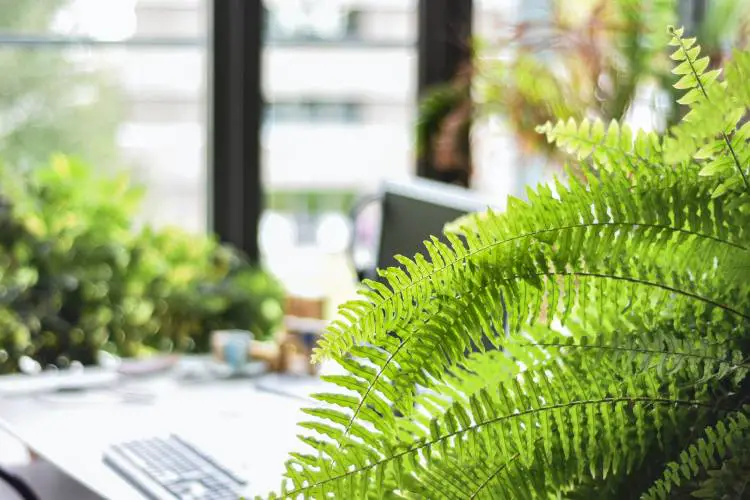
What is the best Boston Fern care? Read the article and find everything about watering, the best temperature, humidity, repotting, propagation, toxicity, and other questions you may be asking about this plant.
| Botanical Name (Latin Name/Scientific Name): | Nephrolepis exaltata |
| Common Name: | Boston fern |
| Light: | medium light (1,000 lux – 2,500+ lux) |
| Watering: | once the top few inches of soil are dry |
| Soil: | well-draining mix |
| Repotting: | once a year |
| Temperature: | 65°F to 75°F (18°C to 24°C) |
| Humidity: | over 50%, but it adapts well to any humidity |
| Toxicity for Pets: | non-toxic |
| Toxicity for Humans: | non-toxic |
| Propagation: |
|
| Pruning: | Prune dead or diseased growth or when you want the plant to branch out |
Light Requirements
| Minimal amount of light: | 1,000 lux (100 FC) |
| Optimal amount of light: | 2,500+ lux (250+FC) |
| Direct sun tolerance: | 1-2 hours |
| Category: | medium light |
Boston fern care favors exposure to medium indirect light (750-3,000 Lux or 75 to 300-foot candles). Exposure to direct sunlight can cause fern fronds to get light green in color or even burn, so it’s best to keep the plant behind sheer curtains or drapes. If you plant your Boston fern outside, make sure to do it under the cover of a tree or keep it in the shadier part of your garden.
If you want to keep it in optimal care conditions indoors, you can also expose it to the growth lights. Check my Growth Light Finder if you are unsure about which one would suit your plant the best.

Boston Fern enjoys medium indirect light
Water Needs
Ideally, you want to water your Nephrolepis Exaltata when the top few inches of soil are dry. You can use a chopstick or a moisture meter to check the soil.
There are no hard and fast rules when it comes to watering your Boston Fern. If your plant is over or under watered, shedding will swiftly occur. Overwatering your plant can lead to the development of root rot—however, do not, under any circumstances let the soil go entirely dry to the bottom of the pot as the plant cannot tolerate it any better than root rot.
Humidity Needs
The ideal air humidity for Boston Fern care is over 50%. Nonetheless, your Neprholepis Exaltata is highly adjustable—like most indoor plants, it won’t suffer even without artificial air humidifiers.
Temperature Requirements
The ideal temperature average for your Boston fern plant care ranges from 65°F to 75°F (18°C to 24°C).
Fertilizing
Fertilizing is not necessary for your Boston Fern plant care, as, if you repot your plant every year, the fresh soil will provide for all the nutrients required. If you wish to improve and quicken the growth, you can still do so— just make sure to follow the instructions on the fertilizer packaging beforehand. Too much fertilizer can seriously damage or even kill a plant. An excellent fertilizer that I recommend for a lot of tropical plants is Dyna Gro Foliage Pro. It contains all 16 macro and micronutrients that plants need.
Soil
As for the best soil for Neprholepis Exaltata, any tropical potting mix can be used. However, it needs to be amended with perlite and possibly another ingredient. What I usually suggest is one part any potting mix, amended with one part perlite and one part bark. By amending the potting mix with additional ingredients we are creating macropores (large pores that contain oxygen) which is very beneficial for the plant, as roots need oxygen to be healthy (roots absorb oxygen and release carbon dioxide).

Boston Fern prefers well-draining soil
Repotting
Regular repotting of your Boston Fern should cover its nutritional requirements. What it will also do is give your plant more room for growth. If your plant needs a larger home, usually the roots will come out the bottom of the pot. There are two common methods for repotting your indoor plants, Nephrolepis Exaltata included: potting up and full repotting.
Potting up is a method better suited for beginner plant parents. What you do here is move a plant along with roots and already existing soil into a larger pot and fill the space with additional soil. Here is how to do this:
1. Start by filling up ⅓ of the new pot with the previously suggested potting mix (potting mix mixes with perlite and bark).
2. Take the plant out of its original pot and mildly loosen the rootball before placing it in a new container. If some of the roots are cut off in the process, don’t worry—your plant will be just fine.
3. Fill the remaining space with the rest of the soil mixture and press it soundly around the plant. You need to make sure that it’s planted at the same depth as before, but leave an inch of space between the soil and the rim of the container so there is room for watering.
As you get more experienced and skilled at plant parenting, you can also go for full repotting.
This means that when you get the plant out of its original container you should also remove all or most of the original soil from the roots. Then you inspect the roots of your plant and remove the dead and rotting ones. The rest of the steps are as it goes in the potting up method. Here is how I did it.
This repotting process is a bit more complicated and it can stress the plant. However, it also provides long-term benefits and improves overall plant care significantly—it will keep the rootball vigorous and oxygenated, providing it with the optimal setting that will ensure the long-term well-being of your plant.

Boston Fern green leaves
Toxicity To Humans
Boston Fern is considered to be non-toxic to humans according to the University of California and shouldn’t cause any unwanted effects if accidentally consumed. It shouldn’t be used, however, as a tea or medicinal herb.
Toxicity To Pets
Although its large fronds may draw the attention of your furry companions, according to ASPCA, is non-toxic for pets.
Pruning
It is optimal to prune your Boston Fern to preserve its health and vigor. You want to remove the dead fronds and fronds that have lost their color, at the base of a plant. To do this you can use a sterilized pair of garden scissors. This will ease up and encourage the breakthrough of new growth.
Propagation
The process of Boston Fern propagation is fairly straightforward and the division is the most popular method for it. As the plant grows, it will put out new ferns next to the original one. To propagate your Boston Fern, you can simply take the whole plant out of the soil and separate or cut the roots to split the individual plants. These plants can then be potted and will grow separately.
FAQs about Boston Fern
We Get Snow in the Winter. Will That Hurt My Boston Fern?
As Neprholepis Exaltata’s optimal temperature ranges from 65°F to 75°F, if it’s planted outside it most definitely will not survive the frost, so it must be brought indoors.
How Big Do Boston Ferns Get?
In its native, subtropical, and tropical environment, Boston fern can grow up to 7 feet tall. However, if it’s placed in a container, under the best circumstances it can reach 3 feet of height, but for the most part, its size will vary between 1 and 3 feet.
What Is the Average Boston Fern Life Span?
As Neprholepis Exaltata is an extremely sturdy plant and can propagate by self-division, with proper care, and under the right circumstances, it can last from multiple years up to several decades.
What Types of Boston Ferns Are There?
There are over 20 different varieties of Boston Fern that share the same care demands but differ in their appearances. Nephrolepis Exaltata Bostoniensis is the most common one, and if you hear someone talking about Boston Fern, it is probably this one. There are also, Florida Ruffle, Hawaiiensis, and Golden Boston just to name a few.
Yours Truly,


Related Posts
Alocasia Flying Squid Care (FULL Guide!)
Black Pagoda Lipstick Plant Care (COMPLETE Guide!)
Sansevieria Trifasciata Black Dragon (FULL Guide!)